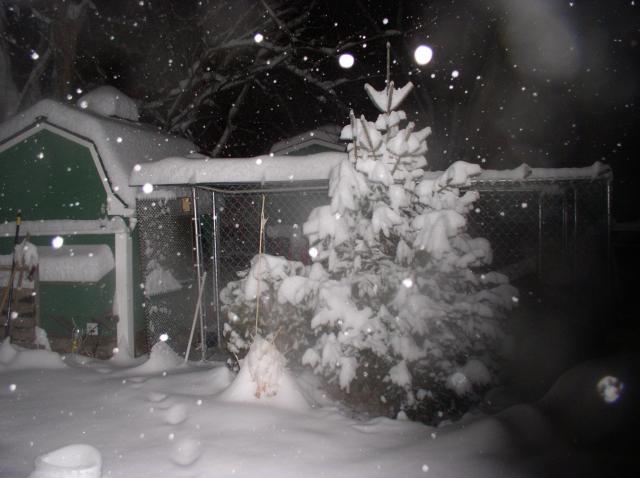I have a long vent like yours on the back of my coops too. The easiest thing to do is to take out the plexiglass and cover the opening with hardware cloth. In really cold weather (we get sub zero temps like you too) I just leave it open an inch or two. With the size of your coop and the number of your chickens that should be sufficient. We also put a moisture barrier and insulation on the ceiling. At Menards we found round vent covers that are about 4" across. If you use a hole saw it is a cinch to put one of those in with a little caulk. put it high on the wall across from the window if you need even more ventilation then just the window.
Navigation
Install the app
How to install the app on iOS
Follow along with the video below to see how to install our site as a web app on your home screen.
Note: This feature may not be available in some browsers.
More options
You are using an out of date browser. It may not display this or other websites correctly.
You should upgrade or use an alternative browser.
You should upgrade or use an alternative browser.
Didn't think about ventilation while building......... HELP!!
- Thread starter spcurtiss
- Start date
I used white round 4 inch plastic louvered covers from Home Depot for the outside to keep rain out and hardware cloth on the inside of 4 inch holes. Would look nice on your pretty henhouse!
Install a ridge vent... cheap, easy and puts the venilation at the highest possible point in your coop. It will always be above your roosting chickens!




 e
eShoot for 1 sq. ft. ventilation per bird. It sounds like a lot but without it inside will have more moisture than out. Also things like ammonia build up and damage birds tiny respiratory systems.
Ridge vents work unless covered by snow, then they're worthless.
Big gable vent's are probably your best bet and won't damage the looks.
Ridge vents work unless covered by snow, then they're worthless.
Big gable vent's are probably your best bet and won't damage the looks.
High vents should be open in the winter. Ammonia is lighter than air and needs to escape (density being 0.589 times that of air).
Quote:
If you are using a light bulb for egg production use a CFL bulb. Little heat, great light, even in cold weather and you can run a 60watt bulb for the cost of a 14 watt. Pain to throw away, but works great for chickens.
If you are using a light bulb for egg production use a CFL bulb. Little heat, great light, even in cold weather and you can run a 60watt bulb for the cost of a 14 watt. Pain to throw away, but works great for chickens.
Quote:
Yup, your right, good point. I didn't even think about the snow for obvious reasons. I live on an island in SE Texas.
Yup, your right, good point. I didn't even think about the snow for obvious reasons. I live on an island in SE Texas.
Quote:
Yup, your right, good point. I didn't even think about the snow for obvious reasons. I live on an island in SE Texas.
I put ridge vents in my first two coops and then this happened.

Even the Cupola vents got clogged. Big windows and gable vents would have been better.
No snow? No problem.
Yup, your right, good point. I didn't even think about the snow for obvious reasons. I live on an island in SE Texas.
I put ridge vents in my first two coops and then this happened.

Even the Cupola vents got clogged. Big windows and gable vents would have been better.
No snow? No problem.
I had not thought of snow blocking certain vents. You learn something on here every day. Another good reason for vents under the overhang if you can.
As an engineer, I'll mention that the little holes don't provide much air exchange. It's due to the friction of air moving along the edges. A hole twice as big will allow a whole lot more than twice as much air to pass through it. I suggest to make your vent holes as big as you can, but remember to put hardware cloth over them so raccoons or such can't climb in.
As an engineer, I'll mention that the little holes don't provide much air exchange. It's due to the friction of air moving along the edges. A hole twice as big will allow a whole lot more than twice as much air to pass through it. I suggest to make your vent holes as big as you can, but remember to put hardware cloth over them so raccoons or such can't climb in.
New posts New threads Active threads
-
Latest posts
-
-
Picture Of The Week (POW) Information & Submissions
- Latest: Antiocheggers
-
-
-
Latest threads
-
Can I edit my thread's title?
- Started by MamaPoult
- Replies: 2
-
-
-
What breed is the bonus chick from greenfire farms?
- Started by Tiger248
- Replies: 1
-
Multiple Alerts for the same one.
- Started by FLORIDA JEFF
- Replies: 3
-
-
Threads with more replies in the last 15 days
-
-
-
Over researched and made myself anxious about coccidiosis
- Started by Echelontheory101
- Replies: 67
-
-
-
×


